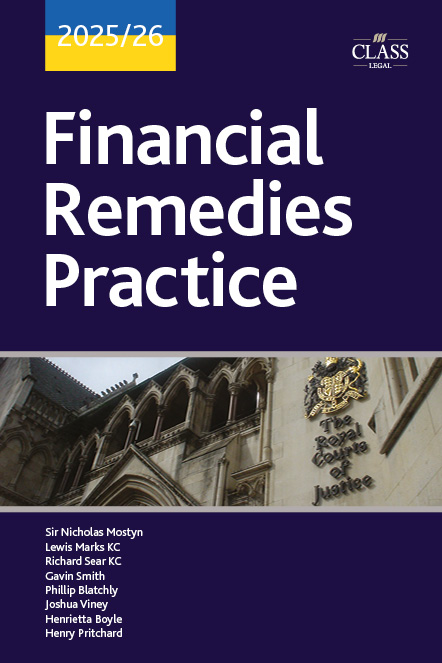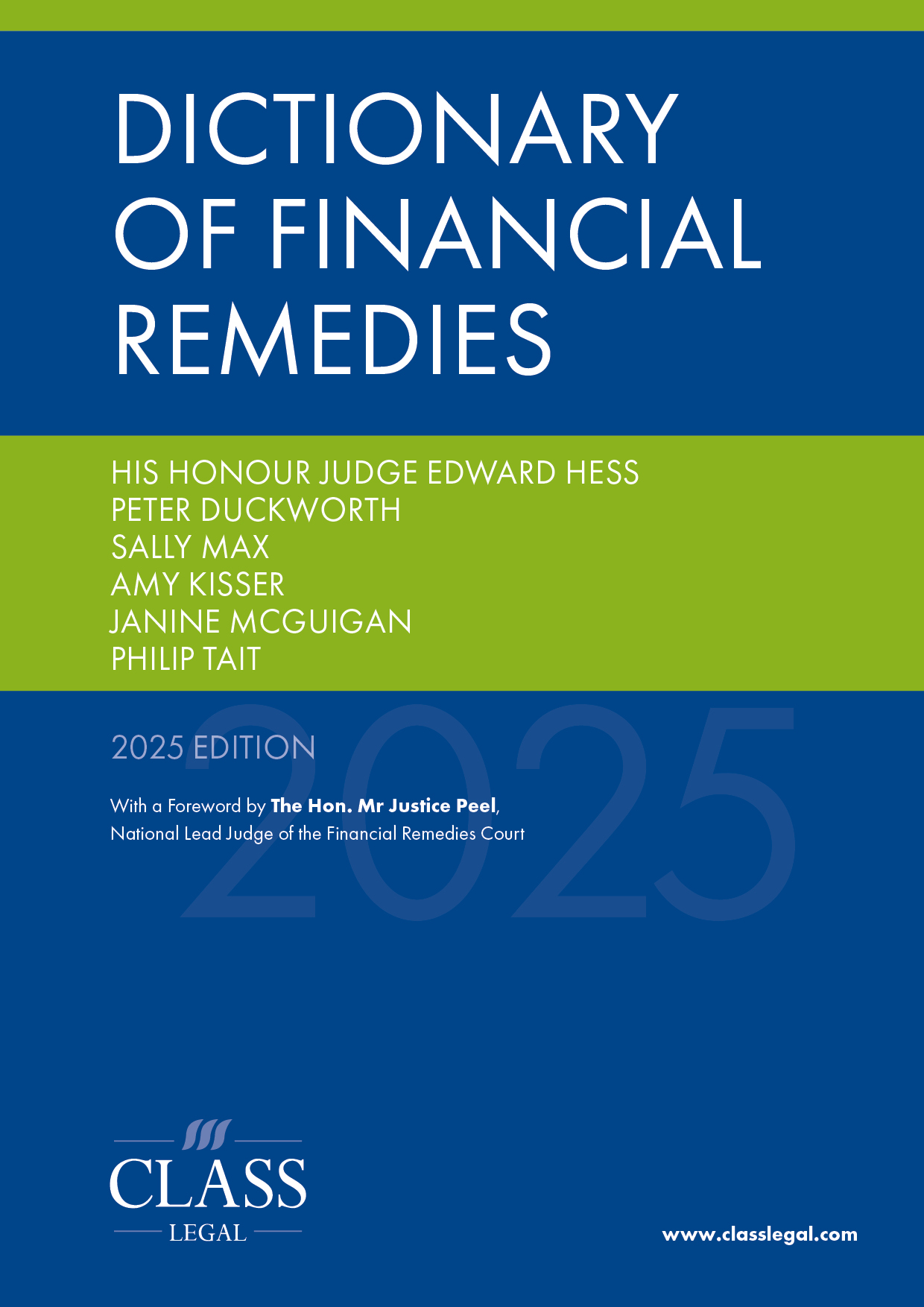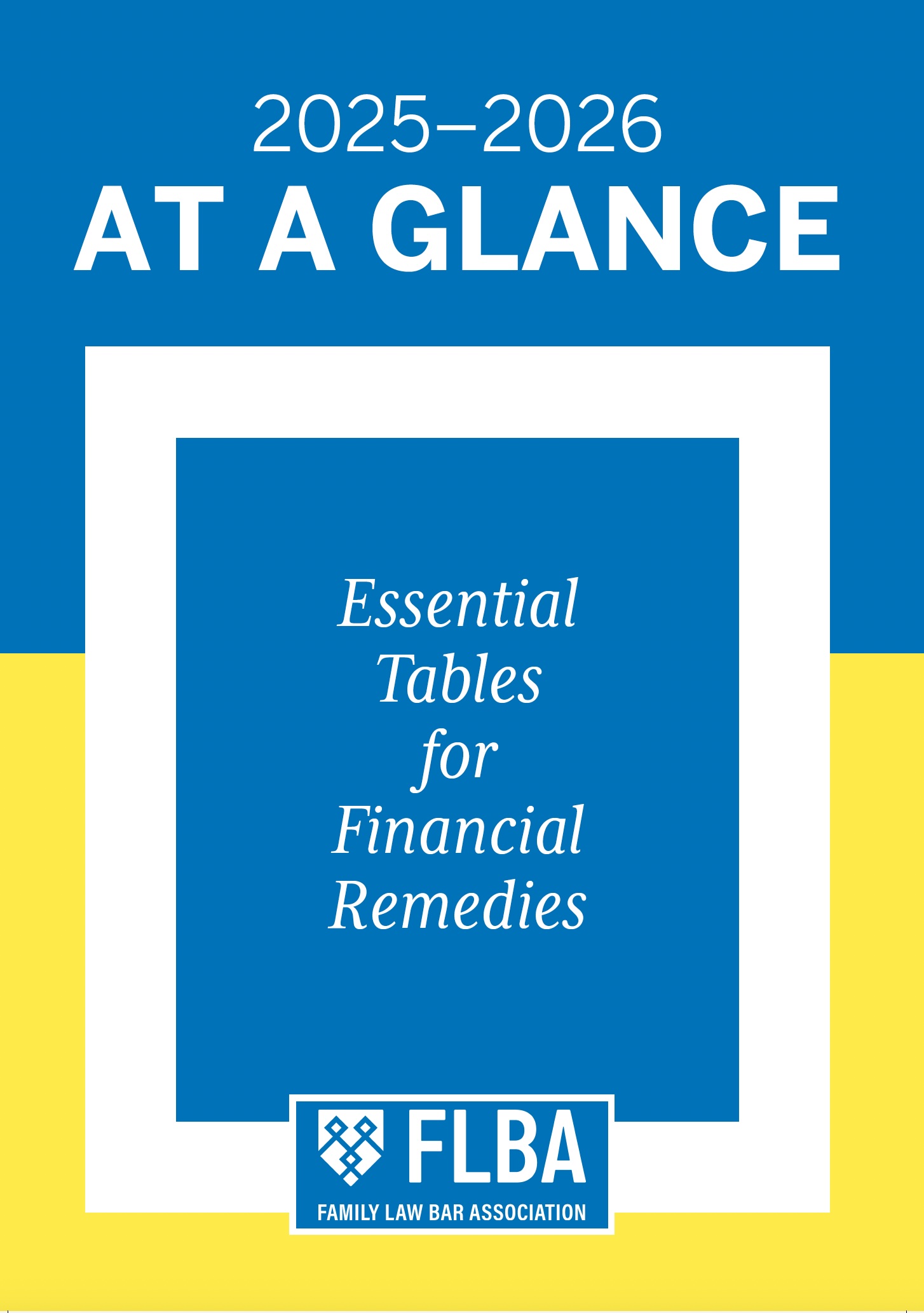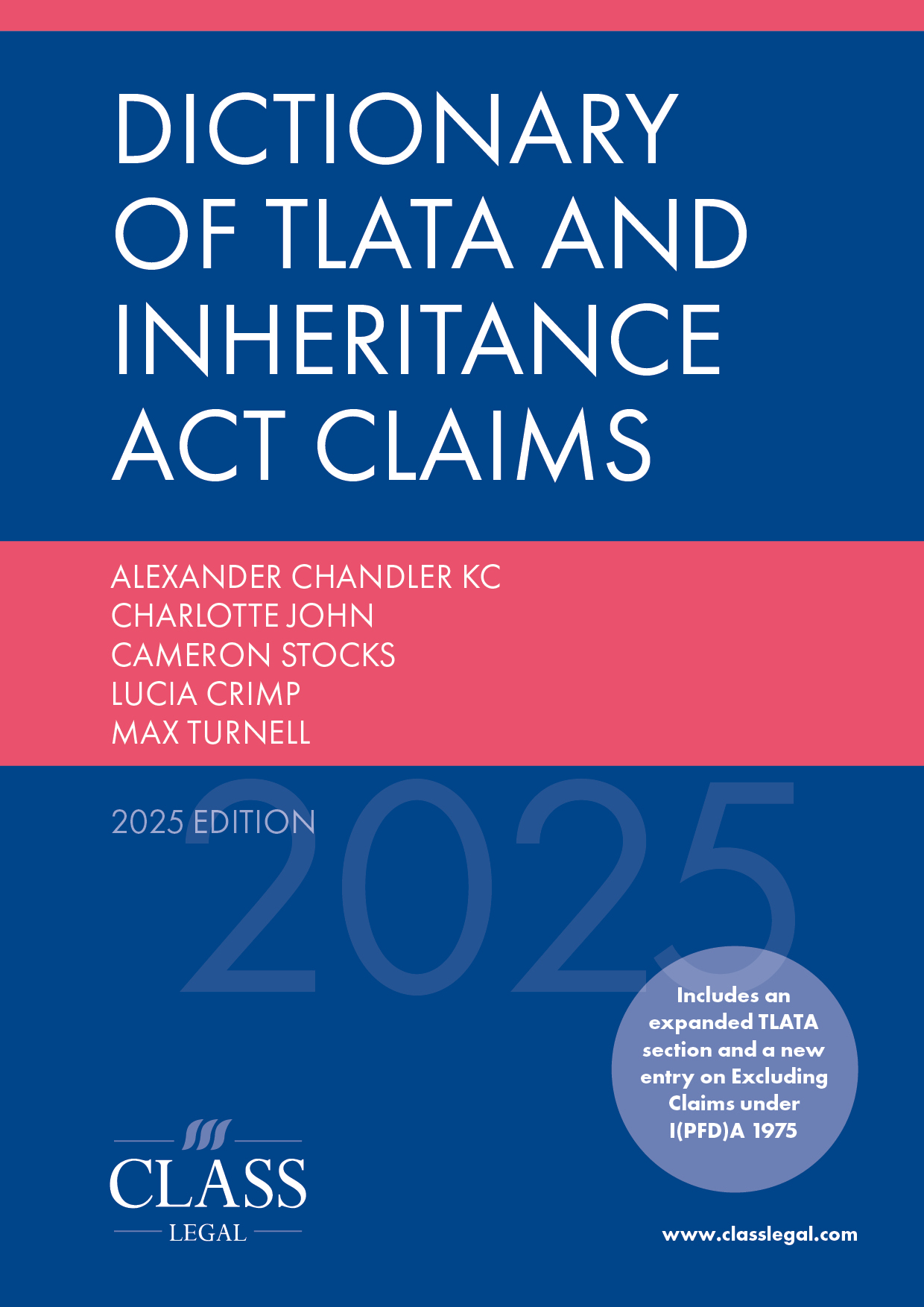
Bad Behaviour and Broken Bonds: A Comparison of Conduct in 1973 and 1975 Act Claims
Published: 30/06/2025 06:00

Introduction
Fifty years ago, the Inheritance (Provision for Family and Dependants) Act 1975 (1975 Act) was enacted in an expansion of the court’s statutory powers for financial provision on death.1 Two years earlier, Parliament had enacted the Matrimonial Causes Act 1973 (MCA 1973) to alter the court’s statutory powers for financial provision on divorce. The government chose not to enact the Law Commission’s recommendation that all family provision claims, both on divorce and on death, be assigned to the Family Division.2 The Chancery Division (now part of the Business and Property Courts)3 and the Family Division both have jurisdiction in 1975 Act claims, with the result that two Divisions are interpreting similar provisions dealing with meeting family needs depending on whether the claim arises on divorce or on death. Below the High Court, the county court not the Financial Remedies Court deals with 1975 Act claims. We examine the difference in the jurisprudence as a result.
Both Acts include conduct as part of the circumstances that the court should take into account when determining the award. Unlike the high test of conduct that is ‘inequitable to disregard’ in the MCA 1973, the language of the 1975 Act permits consideration of conduct that is considered merely ‘relevant’, paving the way for the court to weigh in the balance a much wider range of behaviour in determining a 1975 Act claim. The two sections now read as follows:
- s 25(2)(g) MCA 1973, ‘the conduct of each of the parties, if that conduct is such that it would in the opinion of the court be inequitable to disregard it’ (emphasis added);
- s 3(1)(g) 1975 Act permits consideration of ‘any other matter, including the conduct of the applicant or any other person, which in the circumstances of the case the court may consider relevant’ (emphasis added).
The lack of a principled approach to quantifying poor conduct on the value of the award is often cited as the reason why the Financial Remedies Court cannot take conduct into account. That objection has not so far gained traction with the Business and Property Courts considering 1975 Act claims.
In this article, we take a detailed look at how conduct has been approached in the Business and Property Courts, with a view to both assisting a practitioner dealing with a 1975 Act claim with conduct issues, as well as seeing what the two jurisdictions could learn from each other.
The 1975 Act in overview
The 1975 Act permits the court to make a financial award in favour of a limited category of claimant, including a surviving spouse, as well as other limited categories of claimant such as cohabitants, children and dependants, where the deceased’s will (or the result on intestacy) fails to make reasonable financial provision for that claimant.
All claimants other than spouses are limited to provision for maintenance (defined in the case law as provision to meet their everyday expenses of living). For surviving spouses, reasonable financial provision under the 1975 Act means such financial provision as ‘would be reasonable in all the circumstances of the case for a husband or wife to receive, whether or not that provision is required for his or her maintenance’ (s 1(2)(a)). Spousal claims may therefore be approached more generously in making provision beyond maintenance needs, and the court has to consider what the surviving spouse would have received on divorce (s 3(2)), although this is neither ‘a floor nor a ceiling’ to the claim.
Section 3 sets out the matters that the court must weigh when deciding whether the deceased’s estate has made ‘reasonable financial provision’ for the applicant and, if not, how much provision should be granted, including considerations such as the financial needs and resources of the relevant parties and the size of the estate. In addition to the general provision at s 3(1)(g) requiring consideration of the ‘relevant’ conduct of any person, there are other specific conduct-related considerations that the court is expressly directed to have regard to including contributions made by spousal claimants (s 3(2)) and cohabitee claimants (s 3(2A)) and the extent to which the deceased has assumed responsibility for the maintenance of certain categories of claimant (s 3(3) and (4)).
Conduct under the MCA 1973
We are not going to dwell on how the Financial Remedies Court approaches conduct in this article, as the topic has been set out comprehensively in a previous articles.4 In summary, at High Court level and below, the approach has been set out by Peel J in Tsvetkov v Khayrova [2023] EWFC 130 and N v J [2024] EWFC 184. These two authorities make clear that in order to establish conduct, the party must:
(1) prove the facts relied on;
(2) establish that those facts meet the conduct threshold, which is high or exceptional; and
(3) usually establish that there is an identified (even if not always measurable) negative financial impact of the alleged wrongdoing – whilst the statute does not specifically refer to a financial consequence, Peel J has indicated that cases that take account of conduct that does not have a financial consequence will be vanishingly rare.
If those elements are established, the court will go on to consider how conduct should impact on the outcome of the proceedings taking into account the balancing exercise with the other s 25 factors.
The court’s approach to conduct under the 1975 Act
It is impossible within the scope of this article to exhaustively list the 1975 Act cases in which conduct has been a relevant factor. We highlight below some of the key decisions. Our focus here is on conduct that the court has considered relevant under s 3(1)(g), rather than issues such as contributions to the family made by cohabitees and spouses.
Before we consider the cases in detail, it is worth drawing out a few observations that can be gleaned from the decision of the Supreme Court in Ilott v Mitson.5 The decision is the leading case on the 1975 Act and is primarily of relevance to evaluating claims brought by maintenance-standard claimants, rather than spousal claimants. Nonetheless, there are a number of important observations made in Ilott that have broad relevance to the topic at hand, as follows:
- Testamentary freedom: the Supreme Court at [18] endorsed the comment of Oliver J in Re Coventry (Deceased) [1980] Ch 461, at 474–475 that ‘an Englishman still remains at liberty at his death to dispose of his own property in whatever way he pleases’. Whilst the deceased’s wishes may be overridden, they are part of the circumstances of the case to be assessed in the round with other relevant factors [47].
- Limitations of conduct considerations: conduct is relevant, but ‘care must be taken to avoid making awards under the 1975 Act primarily rewards for good behaviour on the part of the claimant or penalties for bad on the part of the deceased’ [47].6
- Moral claims: financial need was recognised to be a ‘necessary but not a sufficient condition for an order’ in favour of a claimant limited to provision for maintenance [19] – i.e. something more than financial need will usually be required to justify an order. The court noted that the presence or absence of a moral claim, whilst not a sine qua non for provision, will ‘often be at the centre of the decision under the 1975 Act’ [20].
- The focus is on objectively assessing outcomes, rather than the deceased’s reasons: ‘[T]here can be a failure to make reasonable financial provision when the deceased’s conduct cannot be said to be unreasonable. The converse situation is still clearer. The deceased may have acted unreasonably, indeed spitefully, towards a claimant, but it may not follow that his dispositions fail to make reasonable financial provision for that claimant, especially (but not only) if the latter is one whose potential claim is limited to maintenance.’ [17].
- No need to quantify the claim and then apply a discount: ‘The Act requires a single assessment by the judge of what reasonable financial provision should be made in all the circumstances of the case. It does not require the judge to fix some hypothetical standard of reasonable provision and then either add to it, or discount from it, by percentage points or otherwise, for variable factors. To the contrary, the section 3 factors, which are themselves all variables and which are likely often to be in tension one with another, are all to be considered so far as they are relevant, and in the light of them a single assessment of reasonable financial provision is to be made.’ [34].
We return to some of these points in our analysis below.
Evaluating estrangement
Estrangement in parent–child relationships is a persistent conduct-related theme in the case law concerning adult children, for the obvious reason that people do not generally disinherit children with whom they enjoy a good relationship. Examples of cases involving adult children where estrangement or conduct played a central role in the outcome are set out below.
Ilott
The claimant, Heather Ilott, had been entirely disinherited by her mother, Mrs Jackson, who left her entire estate to animal charities. Both women contributed to the estrangement, but the district judge at first instance found that Mrs Jackson bore the larger share of the blame. This, coupled with Heather’s constrained financial circumstances, justified an award in her favour but the long period of estrangement and lack of expectation meant that provision should be limited (£50,000 from an estate of c. £486,000). The Supreme Court found that the first instance judge had been entitled to approach matters as he had. Lord Hughes, giving the lead judgment with whom the rest of the justices agreed, and Lady Hale, who gave a short supplemental judgment, both considered that other judges might legitimately have concluded that no provision at all should be made for the claimant given the very long and deep estrangement. Here, Mrs Jackson’s conduct weighed in favour of provision but simultaneously the resulting long period of estrangement was a depressing factor on the award.
Wright v Waters [2014] EWHC 3614 (Ch)
The conduct of the claimant daughter, Patricia Wright, consisted of refusing to return £10,000 which her mother had transferred to her for investment and writing her mother a letter telling her she was ‘not fit’ to be called a mother and disowning her. That conduct was held to outweigh all factors in her favour so that it was objectively reasonable for no financial provision to be made for her from her mother’s net estate of c. £138,000.
Wellesley v Wellesley & Ors [2019] EWHC 11 (Ch)
The deceased, the 7th Earl Cowley, left only a £20,000 legacy out of a £1.3m net estate to his adult daughter, Tara Wellesley, with the remainder and residue split among his spouse and other children/stepchildren. The estrangement between Tara and her father had lasted most of her adult life. The court considered that Tara chiefly bore the blame for this state of affairs, her behaviour including drug abuse and a ‘bohemian lifestyle’ that affronted her father’s strict moral code. Her responsibility for the extremely long estrangement outweighed the factors in favour of making additional provision for her.
Beneficiary misconduct
The court can also use conduct under s 3(1)(g) 1975 Act to increase the claimant’s award, if the behaviour of the beneficiary defendants is especially reprehensible. The court may also factor in relative culpability in deciding where the burden of meeting the award should fall as between the beneficiaries.
Re Lloyd George Clarke [2019] EWHC 1193 (Ch)
In Re Clarke, the widow’s pressing care needs, due to a stroke suffered after her husband’s death, and serious misconduct by one of the deceased’s daughters led to a significantly enhanced award under the 1975 Act. The marriage between the deceased and his widow, Matilda, had lasted between 13 and 16 years. The deceased’s primary asset was the matrimonial home, worth approximately £1.38m, which he left to his daughters from an earlier relationship, Vinette and Heather, subject to a non-binding wish that they permit Matilda (who was now 82 years old) to continue to live there. Matilda was left a one-third share of the (minimal) residue estate.
Vinette had engaged in extensive misconduct, including misappropriating funds from her father’s accounts, obtaining a lasting power of attorney when he lacked capacity, ignoring disclosure orders, and failing to attend trial. The court found she had misappropriated sums beyond those provable on the banking evidence and drew adverse inferences accordingly. Heather, though less culpable, had also received funds and failed to engage with proceedings.
Deputy Master Linwood did not disregard the daughters’ interests entirely, citing Mr Clarke’s testamentary freedom. Matilda was awarded a lump sum of £731,000 to meet her nursing care needs. He noted that were it not for the poor conduct of the daughters, the residue after making provision for Matilda’s care needs would have been split three ways between the daughters and Matilda. Instead, he reallocated part of the daughters’ entitlements to Matilda in line with their respective wrongdoing, so that Matilda on top of her one-third share of residue received £80,000, forfeited from Vinette’s share (a sum which was double the provable misappropriation to reflect non-disclosure), plus £1,000 forfeited from Heather’s share
The Deputy Master commented that had Matilda remained in good health and the spirit of Mr Clarke’s wishes been followed by the daughters – so that she would be living in the property and would have a share of residue of c. £20,000 – that may well have amounted to reasonable financial provision [229].
Overall, Matilda received around 77% of the net estate outright, as compared to less than 2% under the will. While the lump sum representing the majority of the award was attributable to her care needs, the further reallocation of residue went beyond restitution – had the daughters been ordered to repay the misappropriated sums to the estate, a portion would have been returned to them when the residue was shared. Instead, they forfeited the benefit from those sums entirely. Additionally, the judge treated the gift of the property to the daughters as lapsing, so that the surplus proceeds fell into residue to be shared equally between all three women. This repositioned Matilda’s expected £20,000 share of residue to around £185,000 before the additional forfeiture — a redistribution not explicitly justified by needs, or the divorce cross-check, but seemingly driven by the daughters’ misconduct and failure to engage with the litigation.
Applicant misconduct
Re Snoek [1983] 13 Fam Law 18
The marriage, which lasted for c. 17 years to the date of the petition (the date of separation is not mentioned) initially functioned well. The court accepted that the widow, Finola Snoek, had once been a good mother and supportive of her husband’s photographic business. However, over the final years of the marriage her behaviour had become ‘atrocious and vicious’. The judge cited repeated incidents where she threw objects, punctured car tyres, wrote abusive letters to the husband’s business colleagues and friends, and physically attacked her husband and others. Mr Snoek sought injunctions to restrain her from threatening or assaulting him or damaging his property. She largely ignored the orders, leading to contempt proceedings and her committal to prison. Her conduct had continued when Mr Snoek had been terminally ill. Mr Snoek left nothing to his wife. Finola, aged 45 by the date of the trial, brought a claim under the 1975 Act, arguing for total ownership of the modest estate (valued at c. £40,000).
Wood J applied s 3(1)(g) analogously to the approach to conduct in the decided cases concerning s 25 MCA 1973. Applying Armstrong v Armstrong,7 he held that the test for the relevance of conduct was whether it would offend a reasonable person’s sense of justice if no effect was given to the conduct in deciding the relief. On the facts ‘with hesitant steps’, the judge awarded Finola the sum of £5,000, concluding that a larger sum would not be fair, just or reasonable. Wood J concluded that her conduct had ‘not quite’ cancelled her earlier contributions. What she would have received but for her conduct is not spelt out, but this would seem to be a case where conduct depressed the outcome leading to an award of 12.5% (a low result, notwithstanding the case pre-dating the White ‘yardstick of equality’).
Land v Land [2006] EWHC 2069 (Ch)
This case is a striking example of the court trying to balance both good and bad conduct. The claimant was the (adopted) adult child of the deceased. He had lived with the deceased since he was very young, he had limited education and had given up his job as a labourer to care for the deceased. It is clear he that he was a vulnerable person, although he did not have a formal diagnosis of a developmental disorder. The claimant was convicted of the deceased’s manslaughter because of his poor care provided in the final months of the deceased’s life; including failure to get her medical attention and eventually leaving her lying in her own excrement and urine, causing severe infected bed sores. The claimant was therefore deprived of her estate which was left to him in her will, pursuant to the forfeiture rule.8 The court balanced the claimant’s good and bad conduct towards the deceased, noting that, although in the last 2 months of her life the claimant’s conduct became culpable and blameworthy, he had essentially faithfully discharged his family obligation for a considerable period. He had already been punished by the criminal courts for his conduct, as well as by the forfeiture rule, and should not be punished again by being refused provision under the 1975 Act. The judge awarded the claimant the house to meet his housing needs, and £1,000 from the residue.
Barron v Woodhead [2008] EWHC 810 (Ch)
In Barron v Woodhead, the applicant, Mr Warwick Barron, was a 73-year-old widower. He had been declared bankrupt and was alleged to have disposed of assets, including to his late wife, Ann Waite, to avoid the claims of his creditors. The parties had separated 2 years before Mrs Waite’s death after a relationship inclusive of pre-marital cohabitation of c. 15 years, but they had not divorced. Both were heavy drinkers and there was evidence of domestic violence on both sides.
Mrs Waite left him nothing in her will, dividing her estate of c. £315,000 between her two children of an earlier marriage. Mr Barron sought reasonable financial provision under the 1975 Act. The court concluded that no provision at all was an objectively unreasonable outcome. Whilst stating that Mr Barron’s conduct was not relevant to decrease the award (having regard also to the allegations of violence on both sides) and distinguishing Re Snoek, HHJ Behrens concluded nonetheless that it was not appropriate for there to be a substantial additional capital award in excess of his needs because: (i) the husband had plainly dissipated funds; (ii) any money given to the wife had been given for the husband’s own purposes; (iii) and he had made no financial claim against the wife in the years following the separation. The court’s primary concern was ensuring that Mr Barron had a roof over his head. Mr Barron was awarded a life interest in £100,000, to be used to purchase a home with any surplus was to be invested to produce an income, and an additional lump sum of £25,000 to defray moving expenses and to provide a cushion. Ostensibly, Mr Barron’s conduct did not reduce the award. However, it may be observed that outright provision of only c. 8% of the estate, plus housing on a life interest, is much lower level of provision than might otherwise be expected following a relatively long marriage.
Jassal v Shah [2021] EWHC 3552 (Ch)
Jassal v Shah is a rare example of a case where the court expressed its disapproval of the claimant’s conduct, by applying a percentage reduction to her award.9
The claimant, Srendarjit Jassal, sought provision from the estate of her late partner, Fiaz Shah. It was part of Srendarjit’s case (relevant to explaining their living arrangements) that she had committed benefit fraud in collusion with Fiaz, by claiming housing benefit at properties owned by Fiaz. The judge concluded that her misconduct in defrauding the State with the connivance and probable encouragement of the deceased should reduce but not defeat her claim. Having assessed her needs as requiring c. £485,000 out of an estate of c. £1m, a 20% discount (rounded down to £100,000) was applied to the award that the court was otherwise minded to make ‘to mark the court’s concern at such serious and longstanding conduct’ [67]. This is an unusual case in that the conduct in question did not concern the claimant’s treatment of the deceased but was morally reprehensible conduct by both the claimant and the deceased towards the State. As a result, the claimant received a sum less than that otherwise assessed as being required to meet her needs as a form of penalty imposed by the court. It is not obvious that this was what Parliament had in mind in enacting s 3(1)(g), and it is hard to imagine the Financial Remedies Court penalising a party in the same way.
Sim v Pimlott [2023] EWHC 2296 (Ch)
Valerie Sim claimed under the 1975 Act against the £1.2m estate of her late husband, Dr David Sim, who died amid ongoing and bitter divorce proceedings. This was a long relationship of some 35 years. Valerie made serious allegations of domestic abuse including rape against Dr Sim and had obtained non-molestation and occupation orders shortly before Dr Sim’s death in a nursing home.
His will left her £250,000 on condition that she waived any claim under the 1975 Act and vacated the family home (registered in Dr Sim’s sole name). A further £125,000 was offered if she relinquished her share in a jointly owned Dubai property (valued at c. £130,000). Regardless of those conditions, she was also given a life interest in the residuary estate (c. £600,000 after payment of legacies to grandchildren), but this was subject to the trustees’ overriding powers.
HHJ Hodge KC found her a poor witness, rejected her abuse allegations, and criticised her conduct in Dr Sim’s final months—especially her refusal to care for him, which he viewed as exaggerated and ‘wholly unacceptable.’ He upheld the forfeiture clause, finding the will’s conditional gifts reasonable, and concluded that the forfeited £375,000 (including £125,000 to relinquish property she already owned of equivalent value) plus a life interest had constituted reasonable provision in the circumstances. Despite the long marriage, the outright capital provision for Valerie had been forfeited by her claim reducing her to a life interest only. The judge varied the will only to require trustees to set aside £400,000 to buy Valerie a home for life, since the family home would have to be sold to pay legacies to the grandchildren.
It is difficult to unpick the precise impact of conduct on the outcome of the case. The judge stated that ‘I cannot ignore the way in which the claimant conducted herself towards her husband towards the end of his life’ but did not expressly address the impact of this consideration, although his assessment of Valerie’s conduct and the failed allegations appears to have coloured his view. We find the outcome in Sim striking. The judge may not have been helped by the fact that Valerie represented herself. He appears not to have been referred to prior decisions such as Re Snoek and Barron in which the court has taken an approach consistent with the MCA approach to conduct. The result is far below what Valerie would have been entitled to on divorce, where the conduct issues (if entertained at all) would have been unlikely to impact on the outcome.10 We suggest that the case should be treated as turning on its own particular facts.
Deceased’s conduct
There are surprisingly very few cases in which the deceased’s conduct has been held to have an impact on the award. In Ilott, Mrs Jackson’s unreasonable treatment of her daughter was a tipping factor in favour of the claim. In a similar way, in the county court decision of Nahajec v Fowle, a modest provision of £30,000 from an estate of c. £265,000 was made where the claimant daughter was found not to be at fault for the estrangement with her ‘stubborn and intransigent’ father.11
Unwarranted conduct allegations
Lest it be imagined that it is a conduct free-for-all in the Business and Property Courts, we should temper enthusiasm for running conduct cases by noting first that cases involving a successful conduct element represent only a very small element of the 1975 Act case law. Moreover, unsuccessful conduct allegations may have costs consequences, so they are high risk. For example, in Wooldridge v Wooldridge,12 unsubstantiated allegations of financial impropriety and dishonesty were a contributing factor in ordering the unsuccessful spouse to pay costs on the indemnity basis.
Discussion and conclusions
The Financial Remedies Court no longer strays into assessing the relative blameworthiness of the parties for the breakdown of the marriage and has been keen to eschew any idea that it is a court of morals.13 In contrast, under the 1975 Act, issues such as estrangement between the deceased and the applicant, their respective culpability for the breakdown of the relationship, or whether an applicant can demonstrate a ‘moral’ claim for provision are common themes.
From the above cases, we draw the following general conclusions:
(1) Conduct issues may shape outcomes under the 1975 Act: sometimes decisively as in Wright v Waters.
(2) The decision in Jassal suggests that relevant conduct under the 1975 Act is not restricted to the parties’ conduct towards each other or the deceased.14 That seems like an odd outcome to family lawyers, because the Financial Remedies Court does not engage in penalising parties for their wider conduct.
(3) Claimant misconduct is most likely to have an impact on claims pursued by maintenance-standard claimants, especially adult children, where the need to demonstrate something more than necessitous financial circumstances invites scrutiny of the quality of the relationship and the search for some additional factor such as a moral claim to justify provision.
(4) Claimant misconduct is less likely to eradicate claims by spouses and cohabitants, as demonstrated by Re Snoek, Barron and Jassal. Sim v Pimlott may be regarded as an outlier, but nonetheless demonstrates that outcomes under the 1975 Act can be quite different to outcomes under the MCA 1973.
(5) Reciprocal misconduct on the part of the deceased can temper the impact of claimant misconduct – a feature of Ilott and Barron.
(6) Beneficiary misconduct appears capable of elevating a claimant to a greater level of provision than might have been expected under the MCA 1973 – as for example in Re Clarke.
The Business and Property Courts covet a wide discretion and have not attempted to find a formulation, or set of principles, that lend themselves to ready analysis of the impact of conduct on a claim.
On the contrary, as we have noted, the Supreme Court has specifically said that judges do not need to fix a standard or provision and then discount when considering a 1975 Act claim. In this respect, there is accordance between the approaches under the 1975 Act and under the MCA 1973. The Court of Appeal in Clarke v Clarke,15 considering a matrimonial appeal, rejected counsel’s submission that the court should indicate what would have been awarded but for conduct, then quantify the misconduct in cash and then deduct one from the other saying:
‘[T]he statute defines the judicial task and I am against further elaboration or overlay. There may be cases in which such an exercise would be appropriate in the judgment. There will certainly be cases where it will not. There may be cases in which a judge may adopt such an exercise while feeling his way towards a result.’
Pursuant to either Act, the case law indicates that conduct is factored in on a discretionary holistic adjustment to the financial outcome, rather an award and then deduction. The key distinctions between the two regimes in our view are:
(1) the wider categories of conduct that may be taken into account under the 1975 Act;
(2) the lower threshold in terms of the severity of the conduct that may be taken into account; and
(3) the lack in the 1975 Act case law of the guardrails and procedural rigours that the Financial Remedies Court applies to weed out conduct cases that fall below the bar.
The result of all of this is that it is especially difficult to look at the authorities and advise litigants of the likely impact of conduct on their 1975 Act claim with certainty.16
One justification for the differing approach for conduct between the 1975 Act and under the MCA 1973 is the principle of respecting testamentary freedom. Whilst the Supreme Court in Ilott was at pains to point out that the question is not whether the deceased’s testamentary decision was a reasonable one, inevitably the background to why the deceased failed to make greater provision for the claimant will be part of the story. There is a sentimental and cultural dimension to testamentary freedom that attracts wider public support. Many people view a will as the deceased’s ‘last word’, a final opportunity to express their approval or disapproval of those closest to them – one only has to look at the below the line comments in the Daily Mail on probate and 1975 Act claims to see much of this sort of thinking. Additionally, there are far fewer 1975 Act claims per year than financial remedy claims on divorce.17 Consequently, there is not the same pressure to find readily applicable principles in order to reduce the court burden when it comes to this category of litigation.
A troubling strand of the case law from the financial remedy practitioner’s perspective is the possibility, as for example in Sim v Pimlott, of very divergent outcomes under the 1975 Act than would have been expected on divorce.18 There is a good deal to be said on this topic and we hope to return to this in a subsequent article. Confining ourselves to our current narrower focus on the topic of conduct, we consider that there should be parity between the treatment of spousal conduct in claims on divorce and on death. Whilst according due regard to testamentary freedom, a strong case can be made for distinguishing between spousal and non-spousal claims when it comes to the relevance of conduct. The majority of people would agree that a person should be at liberty to disinherit an undeserving child. In most cases, a spouse will have made substantial financial and non-financial contributions to the marriage, and it should require exceptional circumstances for conduct to override these contributions on death every bit as much as on divorce. Notwithstanding the lower statutory threshold of ‘relevant’ conduct, there is scope for alignment of spousal claims on divorce and death through application of the divorce cross-check (reinvigorating the Re Snoek approach).
One issue that we consider is likely to contribute to inconsistency of outcome between the approach taken to spousal claims on divorce and on death is choice of venue. The Chancery Guide urges ‘careful thought’ as to whether a claim should be commenced in the High Court, and, if so, whether it should be commenced in the Chancery Division or the Family Division.19 This guidance may be thought not to go far enough. In practice, most 1975 Act litigation, including claims by surviving spouses, is dealt with by civil litigators and claims continue to be issued in the civil courts, partly due to the lack of alternative in lower value claims, but possibly also based on an aversion to using the Division that is less familiar to the lawyers involved. 1975 Act claims in the county court are likely to be heard by civil circuit judges, who may not financial remedy ticketed.
There is presently no means of issuing 1975 Act proceedings in the Central Family Court, nor, it seems, any means of transferring them to the Central Family Court. Historically, District Judges of the Principal Registry of the Family Division held jurisdiction to hear 1975 Act cases (and so Ilott was heard at first instance in the PRFD), but this jurisdiction has sadly fallen into abeyance. In the meantime as practitioners, we can do something about this and in the interest or promoting consistency of outcome, we can issue either in the Family Division, where the value of the assets justifies, or otherwise in a county court centre which exercises concurrent Family Court jurisdiction and press for the matter to be listed before an FRC ticketed judge.
Until the statutory framework is reformed or the topic is reviewed by the Court of Appeal, outcomes on death may continue to diverge from outcomes on divorce. Until then, careful thought as to forum – and as to how we frame and argue these cases – is the best that we can do to improve outcomes for clients.









